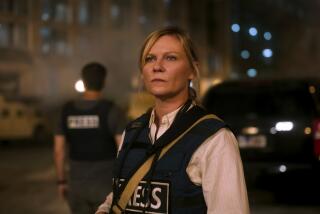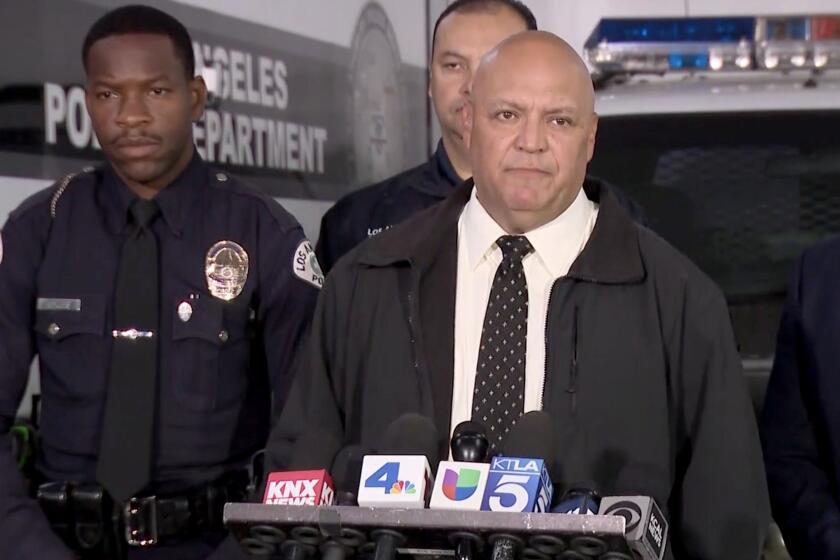Column: The botched new ‘Catch-22’ adaptation reminds us that some novels are unfilmable
The George Clooney-produced miniseries of “Catch-22” began streaming last week on Hulu, and as I watched the first three of its five episodes, an unsettled feeling crept over me.
The advance publicity suggested that this version, as opposed to Mike Nichols’ botched 1970 film, got the book right. Yet almost from the first shot, it seemed wrong: Populated by a mere handful of undifferentiated characters, lugubrious, mild, remote … unfunny.
What happened to the novel of a World War II bombing squadron stationed off the coast of Italy that Joseph Heller wrote? That work was teeming with an enormous cast of easily distinguishable personalities, antic, corrosive, vividly immediate and hilarious.
The viewing sent me back to Heller’s novel, which my Amazon account informed me I had bought for my Kindle in 2011 (though I don’t recall rereading the book at that time). My impression was correct. From the very first page, Heller’s novel vibrates with raw energy.
It’s filled with absurdist humor and recursive dialogue out of Abbott and Costello, but it’s also structured in a looping chronology; Heller introduces characters and incidents with leitmotifs — “the dead man in Yossarian’s tent,” “when Milo Minderbinder bombed the squadron” — that aren’t explained until hundreds of pages later, but give the book a layered atmosphere of foreboding. In short, it’s a brilliant piece of literary work, much deeper than mere military satire.
None of that is translatable to the screen, whether widescreen or small. That brings us to the old saw about how second-rate books make first-rate movies, and first-rate books make clunkers.
“The Godfather” is a second-rate book, but it was the basis of one of the greatest movies ever made. “War and Peace” is the greatest novel ever written, but it can’t adequately be accommodated on the screen even in multiple episodes spread over hours. It’s impossible for film to do justice to Faulkner’s novels except, perhaps, for “Sanctuary,” which he deliberately wrote as a second-rate potboiler, disparaging it as “a cheap idea … deliberately conceived to make money.” (It’s been filmed twice, admittedly not very well.)
There are some obvious reasons why great books are often unfilmable. Great literary works have an inner life that can’t easily be presented through image and dialogue. No film can reproduce the moral dialogue that Leo Tolstoy has with his characters and the reader that makes “War and Peace” a unique reading experience. The key to Faulkner’s greatest novels is a prose style that invests his narratives with the power of Biblical parable, but has no cinematic analogue.
There also are less obvious reasons. One is that adaptations of great works often come to the task with an excess of reverence. The filmmakers are reluctant to communicate the exuberance of some first-rate literary work for fear of seeming disrespectful; the result is an agonizingly slow translation of a work that should move like a pistol shot. Even the generally fine 1981 miniseries of Evelyn Waugh’s “Brideshead Revisited” with Jeremy Irons and Anthony Andrews drained away much of Waugh’s tragic sarcasm. That left mostly the tragedy, which wasn’t as much fun.
One often sees this in film versions of Chekhov plays, which should lend themselves to adaptation much better than they do. For some unaccountable reason, the filmmakers seem to overlook that these plays are comedies. (A sad example is the 1970 Laurence Olivier film of “Three Sisters,” in which the actresses speak their lines as though singing a dirge.)
Filmmakers also have a habit of trying to straighten out the chronology of works that are structured as a series of flashbacks and flash-forwards. The result is almost always a failure; authors employ broken chronologies for dramatic effect and to allow incidents separated by time to comment on each other, all of which is lost when a filmmaker refashions the timeline.
Every so often, a filmmaker charged with placing a classic onscreen will resort simply to impersonation. Joseph Strick took a crack at James Joyce’s “Ulysses” in 1967 for no discernible reason, unless it was to give lovers of the book an opportunity to see Leopold Bloom portrayed by Milo O’Shea.
I recall from seeing the film many years ago that Strick interpolated bits of business and stray images in an attempt to replicate the polymorphous texture of the book, and “Ulysses” aficionados no doubt enjoyed marking these sidelong references and treating them as inside jokes. But they would just whiz over the head of any moviegoer not already deeply familiar with the book.
So what about “Catch-22”? It may be recalled that the movie, written by Buck Henry and directed by Mike Nichols, was a highly anticipated flop, partially because Robert Altman’s “MASH,” which was released almost simultaneously, captured the tone of “Catch-22” better than Nichols’ film. “Catch-22,” the book, proved to be a much bigger influence on “MASH” than on its own film adaptation.
The producers of the miniseries made a number of deliberate choices that carried the series far from the book, for unclear purpose. A multitude of characters have been shorn away, cut back, or changed beyond recognition. In the series, John Yossarian, Heller’s main character, is a generally silent observer of the lunacy around him; in the book, he’s a voluble loudmouth placed at the dead center of events. (Some of the differences between the book and the miniseries are listed here by Vulture.)
But that prompts the question of why the filmmakers chose to make this series at all? Heller’s 1961 novel is still in print and popular — a 50th anniversary edition was brought out in 2010 and the book sells 85,000 copies a year, according to Christopher Buckley’s introduction for that edition — but it’s not exactly at the center of the consciousness of today’s television audience.
“Catch-22,” the novel, continues to influence American culture today. One finds its echos in the works of Thomas Pynchon and the mordant antiwar satire of “Dr. Strangelove (which marked its 50th anniversary in 2014), and “MASH” the film, and even “MASH” the TV series, even though it reduced the cheery profanity of the film to sitcom-level blandness.
And of course there’s the term “catch-22” itself, which long since entered the cultural lexicon, repeated by millions who never read the book and may not even be aware it exists. To them I recommend a first reading, and to those who read it in the past, whether 30, 40, or 50 years ago, I recommend a rereading. It holds up astonishingly well. Skip the series.
More to Read
Start your day right
Sign up for Essential California for news, features and recommendations from the L.A. Times and beyond in your inbox six days a week.
You may occasionally receive promotional content from the Los Angeles Times.







